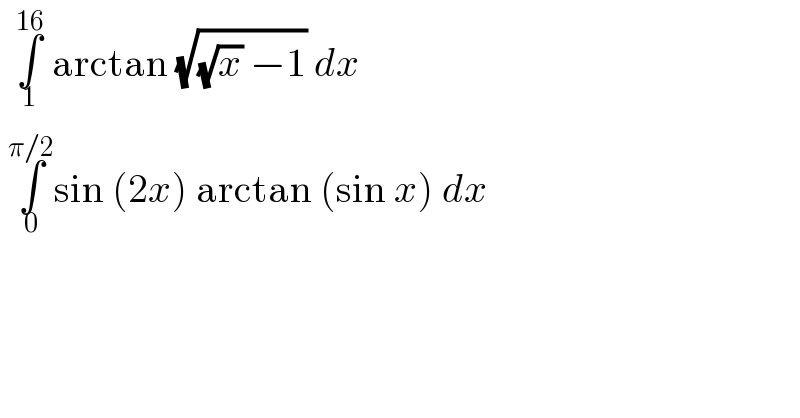
Question and Answers Forum
Question Number 122587 by bramlexs22 last updated on 18/Nov/20

Answered by MJS_new last updated on 18/Nov/20
![∫sin 2x arctan sin x dx= [by parts] =−(1/2)cos 2x arctan sin x +(1/2)∫((cos x cos 2x)/(1+sin^2 x))dx= (1/2)∫((cos x cos 2x)/(1+sin^2 x))dx= [t=sin x → dx=(dt/(cos x))] =−(1/2)∫((2t^2 −1)/(t^2 +1))dt=−∫dt+(3/2)∫(dt/(t^2 +1))= =−t+(3/2)arctan t =−sin x +(3/2)arctan sin x =−sin x +((3−cos 2x)/2)arctan sin x +C ⇒ answer is (π/2)−1](Q122594.png)
Answered by liberty last updated on 18/Nov/20
![(1) ∫_1 ^(16) arctan (√((√x)−1)) dx letting (√((√x) −1)) = ♭ → { ((♭=0)),((♭=(√3))) :} ⇒(√x) = ♭^2 +1 ⇒x=(♭^2 +1)^2 ⇒ dx = 4♭(♭^2 +1) d♭ R=∫_0 ^(√3) (4♭^3 +4♭) arctan ♭ d♭ [ D.I method ] R = [ (♭^4 +2♭^2 ) arctan ♭ ]_0 ^(√3) −∫_0 ^(√3) [((♭^4 +2♭^2 )/(1+♭^2 ))] d♭ R= 5π−∫_0 ^(√3) (((1+♭^2 )^2 −1)/(1+♭^2 )) d♭ R=5π−∫_0 ^(√3) (1+♭^2 )d♭+∫_0 ^(√3) (d♭/(1+♭^2 )) R=5π−(♭+(1/3)♭^3 )_0 ^(√3) +arctan (♭)]_0 ^(√3) R=5π−2(√3)+(π/3) = ((16π)/3)−2(√3). ▲](Q122595.png)
Answered by MJS_new last updated on 18/Nov/20
![∫arctan (√((√x)−1)) dx= [by parts] =xarctan (√((√x)−1)) −(1/4)∫(dx/( (√((√x)−1))))= −(1/4)∫(dx/( (√((√x)−1))))= [t=(√((√x)−1)) → dx=4(√x)(√((√x)−1))dt] =−∫t^2 +1dt=−(t^3 /3)−t= =−(((2+(√x))(√((√x)−1)))/3) =xarctan (√((√x)−1)) −(((2+(√x))(√((√x)−1)))/3)+C ⇒ answer is ((16π)/3)−2(√3)](Q122598.png)
Commented by liberty last updated on 18/Nov/20

Commented by MJS_new last updated on 18/Nov/20

Answered by Dwaipayan Shikari last updated on 18/Nov/20
![∫_1 ^(16) tan^(−1) ((√((√x)−1)))dx x=t^2 ⇒1=2t(dt/dx) ∫_1 ^4 2t tan^(−1) ((√(t−1)))dt t−1=u^2 ⇒1=2u(du/dt) 4∫_0 ^(√3) u(u^2 +1)tan^(−1) udu ∫u^3 tan^(−1) udu=(u^4 /4)tan^(−1) u−(u^3 /(12))+(u/4)−(1/4)tan^(−1) u ∫utan^(−1) udu=(u^2 /2)tan^(−1) u−(u/2)+(1/2)tan^(−1) u So it becomes 4[(9/4).(π/3)−((3(√3))/(12))+((√3)/4)−(π/(12))]+4[(3/2).(π/3)−((√3)/2)+(π/6)] 5π+(π/3)−2(√3)=((16π)/3)−2(√3)](Q122613.png)
Answered by Bird last updated on 18/Nov/20
![I =∫_1 ^(16) srctan((√((√x)−1)))dx changrment (√((√x)−1))=t give (√x)−1=t^(2 ) ⇒(√x)=t^2 +1 ⇒ x=(t^2 +1)^2 ⇒ I =∫_0 ^(√3) arctan(t)4t(t^2 +1)dt =4 ∫_0 ^(√3) (t^3 +t)arcctant dt =4( ((t^4 /4)+(t^2 /2))arctsnt]_0 ^(√3) −∫_0 ^(√3) ((t^4 /4)+(t^2 /2))(dt/(1+t^2 ))} =4{( (9/4)+(3/2))(π/3)}−∫_0 ^(√3) ((t^4 +2t^2 )/(t^2 +1))dt =(9+6)(π/3)−∫_0 ^(√3) ((t^4 +2t^2 )/(t^2 +1))dt =5π−H H =∫_0 ^(√3) ((t^2 (t^2 +1)+t^2 )/(t^2 +1))dt =∫_0 ^(√3) t^2 dt +∫_0 ^(√3) ((t^2 +1−1)/(t^2 +1))dt =[(t^3 /3)]_0 ^(√3) +(√3)−[arctan(t)]_0 ^(√3) =(√3)+(√3)−(π/3)=2(√3)−(π/3) ⇒ I =5π−2(√3)+(π/3) =((16π)/3)−2(√3)](Q122687.png)
